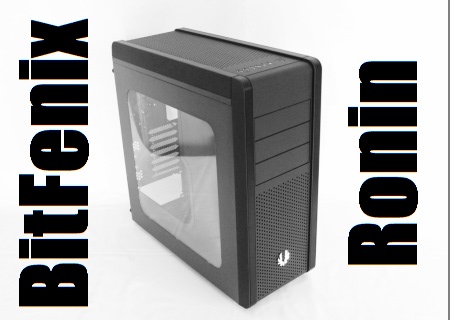BitFenix Ronin Review
Â
Conclusion
With it’s large window all black styling, Soft touch finish and native water cooling support the BitFenix Ronin appears to have it all covered. The Devil they say is in the detail though so let’s delve a little deeper.
Certainly on the small side for a mid tower at 205x483x505mm the Ronin is no less imposing. It is perhaps though it’s slim 205mm width that limits the maximum fan size in the front to 120mm. With only one fan included in this position you may wish to add another if you’re going to be running a high overclock or are overly concerned about temps. All that said, the fan you do get in the front is in fact one of the excellent Bitfenix Spectre fans as opposed to the all to common OEM units seen in a great deal of other manufacturers cases.
With 6 x 3.5″/2.5″ bays there’s plenty of storage. As optical drives are beginning to die a death there’s no longer a need for oodles of 5.25″ bays. The 3 x 5.25″ bays provided should be more than enough for a bay res, fan controller (for none is included) and if you absolutely have to a good old fashioned optical drive.
In these days of monster GPUs it’s absolutely essential that any modern PC case worth its salt can hold a Graphics card the size of a surf board. With the upper drive cage removed you may lose 3×3.5″ drive placements however the max GPU length is upped from a very reasonable 310mm to a more than generous 420mm. Looking at the rest of the interior, when it comes to space BitFenix appear to have become proponents of the Japanese “Lean” principles. Although the case is small it’s not cramped on any way, there’s just enough room for everything with nothing left to spare, so no wastage. And no wasted space means no wasted materials and therefor cheaper production costs and a lower retail price. This approach has been carried through to the oft neglected rear of motherboard area. 20mm of space isn’t a great deal by modern case standards, however 22 well distributed cable tie points mean this space becomes more than enough as cables can be routed exactly where they are needed as opposed to having to be bunched together around available tie points.
While on the subject of space, we’ve seen many a larger case that does not offer native water cooling support. By means of off-set bolt holes and the fans mounted in the roof space, rads of up to 50mm thick can be used even with tall RAM. If you have low profile or even more normally proportioned RAM where the top of the RAM is no higher than 34mm from the surface of the motherboard then a push pull set up is certainly on the cards. BitFenix also provide holes in the roof for 140mm fans.  Like the 240mm fittings the screws have a 15mm spacing so theoretically a 280 Rad no thicker than 40mm could be placed in the roof. We say theoretically as there are likely to be end tank clearance issues with the rear of the 5.25″ bays, still, that’s what the Dremmel was invented for. If water cooling’s not your thing then take solace in having 170mm of clearance for a honking great CPU tower heatsink of your choice
Turning back to aesthetics, BitFenix have realised that opinion is very much divided between those who love to have a massive case window and those that would rather limit the scope of the window to merely presenting the “sexy” part of the interior. To answer this BitFenix have developed the Stealth Cover. Essentially an L shaped piece of contoured carbon fibre effect plastic that is clipped inside the case in such a way as to mask off the drive bays and PSU areas of the interior. We suspect this will something of a Marmite feature, but whether you like it not there’s no denying it does its job well.
So far so good then, but as we said at the beginning, the devil is in the detail and we’re not OC3D with no good reason. The BitFenix Ronin does have a few areas where things could be improved. Whether these are important to you is up to you. Firstly we feel that in a case with such a large side window that is obviously making a feature of showing off the interior it’s a bit of a bad decision not to garnish the 3 cable management holes with rubber grommets. The similarly priced Ghost and the Raider both have grommets, and they don’t even have “look at me” windows, making it quite hard to follow BitFenix’s logic. We’re also a bit disappointed that the tint and texture of the side panels aren’t better in keeping with that of the soft touch coated roof and front.
At a smidge under £70 the Ronin drops right into the heart of enemy territory. It’s up against some pretty stiff competition, and not only from its own team mates in the shape of the Raider and the Ghost, the latter of which also supports roof mounted 240mm rads. Basic flavours of the stalwart CM690 II can also be had for less than £70 with more advanced models costing a bit more, again with native water cooling support in the roof, albeit without quite as much room to play with. If you’re into sleek and silent then both the Nanoxia Deep Silence and DS2 also have native water cooling support, with the original DS1 offering both roof and front rad options. The real thorn in the side of the Ronin though has to be the Arc Midi V2. Admittedly it’ll set you back a fiver or so more, but it water cooling’s you’re thing and you’re looking to mount some seriously thick rads with low speed low noise fans then it can offer what the Ronin can’t.
The Ronin is by no means a bad case, far from it. However, our standards are high here at OC3D and the Ronin just fails to meet the grade when it comes to the coveted Gold award. Second step it is then for a well earned Silver.Â
Thanks to BitFenix for the Ronin on review today, you can discuss your thoughts in the OC3D Forums.Â




